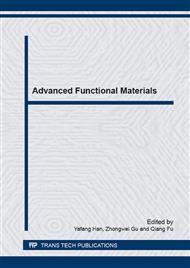p.207
p.211
p.217
p.222
p.227
p.233
p.241
p.248
p.254
Effect of Thickness on Mechanically Tunable Magnetic Anisotropy of FeGa Thin Films Deposited on Flexible Substrates
Abstract:
A practical way to manipulate the magnetic anisotropy of magnetostrictive FeGa thin films grown on flexible polyethylene terephthalate (PET) substrates is introduced in this study. The effect of film thickness on magnetic properties and magnetostriction constant of polycrystalline FeGa thin films was investigated. The anisotropy field Hk of flexible FeGa films, i.e., the saturation field determined by fitting the hysteresis curves measured along the hard axis, was enhanced with increasing the tensile strain applied along the easy axis of the thin films, but this enhancement via strain became unconspicuous with increasing the thickness of FeGa films. In order to study the magnetic sensitivity of thin films responding to the external stress, we applied different strains on these films and measure the corresponding anisotropy field. Moreover, the effective magnetostriction constant of FeGa films was calculated from the changes of both anisotropy field and external strain based on the Villari effect. A Neel’s phenomenological model was developed to illustrate that the effective anisotropy field of FeGa thin films was contributed from both the constant volume term and the inverse thickness dependent surface term. Therefore, the magnetic properties for the volume and surface of FeGa thin films were different, which has been verified in this work by using vibrating sample magnetometer (VSM) and magneto-optic Kerr effect (MOKE) system. The anisotropy field contributed by the surface of FeGa film and obtained by MOKE is smaller than that contributed by the film volume and measured by VSM. We ascribed the difference in Hk to the relaxation of the effective strain applied on the films with increasing the thickness of films.
Info:
Periodical:
Pages:
227-232
Citation:
Online since:
March 2015
Authors:
Price:
Сopyright:
© 2015 Trans Tech Publications Ltd. All Rights Reserved
Share:
Citation:


